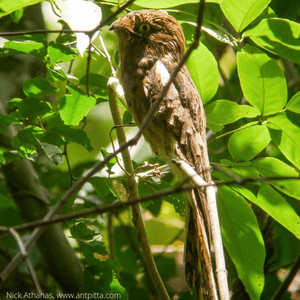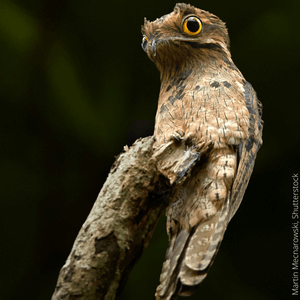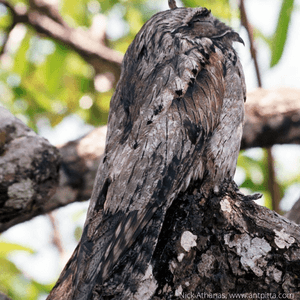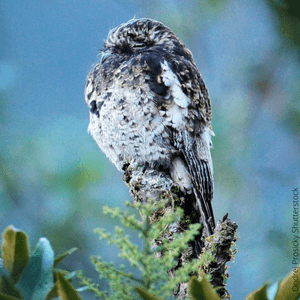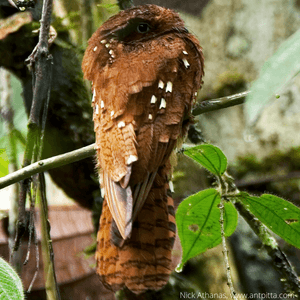Potoos: Bizarre Nocturnal Birds Hiding in Plain Sight
Spend enough time on the internet and you'll inevitably come across a meme featuring a photo of a bird with googly yellow eyes, captioned with text that purports to explain its bedraggled appearance. This is a potoo, a bird that one ornithologist famously described as “little more than a flying mouth and eyes.” Despite looking like they just stepped out of the Muppets, potoos are a real family of nocturnal birds that are found in the Neotropics.

Common Potoo. Photo by Fabio Maffei/Shutterstock.
What Is a Potoo, Anyway?
Potoos (pronounced POE-toos) are members of the bird family Nyctibiidae, which contains two genera, Nyctibius and Phyllaemulor. There are seven different species of potoo, which are found in Mexico, Central and South America, and the Caribbean. They're cousins of the nightjars (the family that includes nighthawks and whip-poor-wills), but despite their big eyes and nocturnal habits, they're not closely related to owls.
Depending on the species, potoos can be anywhere from eight inches to just under two feet long. In addition to oversized eyes, key traits of these birds include large heads, short necks, long bodies, and small, curved bills. Although today they're only found in the Neotropics, they once ranged much farther — potoo fossils dating as far back as the Eocene Epoch, which occurred from 56 to 34 million years ago, have been found in France and Germany.
During the day, potoos hide in plain sight, perching in trees and relying on their resemblance to broken-off branches to keep from being noticed. This works because they hold perfectly still and are covered in gray and brown plumage, which closely resembles tree bark. Potoos can make themselves look even more like stumps by assuming a unique “cryptic” posture: They stretch out until their heads are completely vertical, close their eyes, and compress their head feathers. Unique slits in their eyelids let them keep tabs on their surroundings even with their eyes closed.
Potoo Behavior and Ecology
Potoos live in tropical forests and savannahs. After hunkering down during the day, they spend the night catching flying insects (and occasionally bats and small birds!). These nocturnal insectivores prefer to hunt from exposed perches, waiting for potential prey to approach before swooping out and seizing it in their gaping mouths. Potoos' long wings and tails help them maneuver as they chase potential meals through the trees.
You might be able to spot these birds at night by looking for their eyeshine, which reflects back in the beam of a flashlight, but you're more likely to hear the eerie sounds these birds make. Each potoo species has its own unique call, given on moonlit nights.

Common Potoo in flight. Photo by Jiri Hrebicek, Shutterstock.
Potoo sounds range from the reverberating roar of the Great Potoo to the melodic, descending song of the Common Potoo, to the guttural shriek of the Northern Potoo. You can listen to all three below.
The Northern Potoo used to be considered a subspecies of the Common Potoo, but the two were eventually separated in part by their different calls. Some Indigenous people in South America have developed folklore around potoo calls, believing the sounds to be children calling for lost parents or wives calling for lost husbands.
There are a lot of unanswered questions about potoos. Ornithologists aren't sure how old they are when they start breeding, how far young potoos disperse when they leave the nest, or how long these birds live. But we do know about their nests, or, rather, lack thereof.
Instead of building a nest, female potoos lay a single egg in a knot hole or a crevice in a branch. The egg hatches after about a month, and both parents help take care of the chick, regurgitating insects for it to eat. By the time it's two weeks old, the chick is already learning how to stretch out and point its bill to make itself look more like a branch.
Meet the Seven Potoos
Great Potoo (Nyctibius grandis) The largest potoo at nearly two feet long, the Great Potoo can also be recognized by its reverberating roar. Ranging throughout much of Central and northern South America, this potoo is so big that it's been known to catch and eat bats and smaller birds, in addition to insects. |
Long-tailed Potoo (Nyctibius aethereus) Three subspecies of this potoo are found in different lowland forest regions in South America. As its name suggests, it has a longer tail than most of the other species in the potoo family. |
Common Potoo (Nyctibius griseus) Perhaps the best-known potoo, Common Potoos are famous for their melodic, descending song. In addition to forested habitat, they can be found along forest edges and in open woodlands. |
Northern Potoo (Nyctibius jamaicensis) As noted above, the Northern Potoo is so similar in appearance to the Common Potoo that they used to be considered the same species, but they were eventually separated based in part on how different their calls are — unlike the haunting melodies of the Common Potoo, the Northern Potoo produces a guttural shriek. |
Andean Potoo (Nyctibius maculosus) This rare species lives at higher elevations than other potoos, found up to at least 9,000 feet in the humid forests of the Andes. Because it is so seldom seen, very little is known about its habits. |
White-winged Potoo (Nyctibius leucopterus) Like the Long-tailed Potoo, this species' distinctive feature is right there in its name: It has long white patches in its wings, making it unique among potoo species. It lives in the Amazon and seems to prefer habitat with poor, sandy soil. |
Rufous Potoo (Phyllaemulor bracteatus) This diminutive reddish-brown potoo is less than ten inches long, making it the smallest member of the family. Along with the Andean and White-winged Potoos, it is rare and not often observed by birders or scientists. |
Potoo Conservation
Although none of the potoos are considered threatened, there is reason to be concerned. All seven species are experiencing population declines. In some cases, we know that habitat loss is responsible for these drops; however, answers remain elusive for lesser-known species such as the Andean Potoo. American Bird Conservancy and our local conservation partners have created and expanded 38 bird reserves in 10 countries that provide habitat for all potoo species.
 | Rebecca Heisman is a science writer based in eastern Washington. Her first book, which tells the scientific backstory of how we know what we know about bird migration, will be out in spring 2022. |






































